Bolo do Caco, Flatbread of Madeira
Madeira is an archipelago, a group of islands about 700 kilometers off the Moroccan coast; it is also the name of the largest island in the archipelago, which it shares with another large island called Porto Santo; a small group of long narrow uninhabited islands called the Ilhas Desertas, or desert islands, about 25 kilometers from the southeast corner of Madeira Island. Madeira is also the name of the autonomous region of Portugal that governs these islands, one of two existing remnants of Portugal’s imperial past. Unlike many former colonies though, there were no indigenous inhabitants when Portuguese sailors “discovered” Madeira in the 15th Century and returned to colonize the islands. There are passages in Pliny and Ptolemy and English legends that may describe the islands, legends that may reference them in other cultures, but no permanent settlement appears to have been established before the Portuguese.
As a result, Madeiran cuisine does not have the clash of cultures that features in many colonial cuisines, that hybrid of indigenous flavors and techniques with the comfort foods of home transported to a new land by its imperialist occupiers. However, location alone, or terroir if you prefer a fancier term, does put its stamp on a culture and its cuisine. Madeiran cuisine shares some features with that of Portugal, but with some unique local delicacies like limpets, molluscs that are grilled in their shells and served with garlic and butter; fish stews featuring whatever bounty has been pulled from the sea on a given day; espeteda or small cubes of beef that are threaded onto skewers made from branches of the local bay laurel trees, infusing the meat with a unique piney, almost medicinal flavor. And to help stretch their supply of grain, the local bread called bolo do caco incorporates mashed sweet potato into the dough to supplement the wheat flour. The resulting wet, sticky dough is formed into flat cakes, or bolo in Portuguese, and baked on a flat stone griddle called a caco, to make something that is often described as being much like a wider, flatter English muffin.
A wider, flatter English muffin describes what I was able to make fairly well. Based on a number of Portuguese-language recipes I had Google Translate mangle for me, and on some of my own preferences (such as adding sourdough discard and doing an overnight ferment for some additional flavor), I put together this recipe. The sweet potato is not readily apparent, but the flatbreads have a terrific flavor, soft-crumbed with varying amounts of browning or even charring on the few that I may have burnt a bit.
Bolo do caco
Ingredients
- 200 grams cooked sweet potato
- 7 grams kosher salt
- 500 grams all-purpose flour
- 350 ml lukewarm water
- 1 tbsp instant yeast
- 150 grams sourdough discard
Instructions
- Cook the sweet potato by baking it in its skin, if possible. Peel and separate 200 grams, leaving the rest aside for another purpose. Rice it into a mixing bowl.
- Add salt to the riced sweet potato and mix it thoroughly with a spoon until smooth.
- Add remaining ingredients and mix on medium to high speed with a dough hook until the dough is smooth and pulling away from the sides of the bowl, 10 minutes or so. It will be a wet, sticky dough but should eventually come together.
- Transfer dough to an oiled bowl, cover with oiled saran wrap, and allow to rise in refrigerator overnight.
- Remove from refrigerator, turn out onto a floured surface. Separate into 8-10 pieces of 130-150 grams each and roll into balls. Place balls on well-floured surface and flour the tops as well. Rest for 15 minutes.
- Roll balls into circles of 5-6" that are 1/2-3/4" thick. Flour, cover, and allow to proof for 45 minutes to an hour or until 1 1/2" thick or so.
- Cook bread on griddle over medium heat for 8 minutes per side, turning frequently to avoid burning on hotspots. Wrap finished flatbreads in a clean kitchen towel while cooking remaining pieces.
One of the more common uses of this bread, served beside a meal, perhaps, is to simply split the still-warm flatbread in half as you would an English muffin (I did not try the fork split method but I feel that this bread is a little too large for it), and spread it with a compound butter made with garlic and herbs. I made this one with parsley, chives, a little cilantro, and just a whole lot of garlic.
Now you may be thinking, Jim, I’m all for the inclusivity you demonstrate when talking about sandwiches, but isn’t what is essentially a fancy garlic bread taking things a little too far? Perhaps you are right, or would be if that is the only way Bolo do Caco was served. But that is not the case. According to Wikipedia, bolo do caco is sometimes “eaten as a sandwich with octopus, espetada, milho frito or as a prego…” That particular phrase is a useful search if you’d like to demonstrate to yourself how many different websites simply copy their content from Wikipedia. But it does appear to be the case; Taste Atlas says much the same thing but with less detail; Time Out did an article about 4 can’t-miss sandwiches on Madeira made with bolo do caco; Trip Advisor is full of reviews that people wrote after eating bolo do caco sandwiches on Madeira.
One of the things I noticed while researching this article was the many photos online of street food stands on Madeira serving bolo do caco bread stuffed with Portuguese sausages. So I started by making my own version of a Portuguese sausage sandwich in bolo do caco. This is Portuguese Linguiça from Paulina Market in Chicago, in a garlic-buttered bolo do caco, with grilled onions and an alpine cheese (Roth Grand Cru from Wisconsin, absolutely nothing to do with Portugal or Madeira but I thought it would be a good match for the Linguiça and it was), reheated on a griddle to melt the cheese and garlic butter.






This Linguiça from Paulina Market is a cured, dried, smoked product in a hog casing, more like a narrow and spicy salami than a sausage link that you’d eat in a bun. Still, it is similar in flavor to the chouriço that would normally be baked into bolo do caco by street vendors on Madeira, but more intense–bright red from paprika as much as from the curing process, spicy and garlicky. Sliced thin and fried up in a pan, it makes for a salami scramble that would do my Uncle Mike proud. In this particular application, the sweet cooked onions and the creamy, nutty, almost fruity Grand Cru cheese help tame the fiery sausage. Once again I’ve used the garlic and herb butter on the bread, providing the sandwich additional layers of flavor that perhaps it does not need.

Of course we’ve covered Portuguese sandwiches before on the Tribunal. When many people think of Portuguese sandwiches, the first one that comes to mind is the massive Francesinha, a delicious and incredibly savory Croque Monsieur variant stuffed with multiple meats–steaks, sausages, ham–before being covered in cheese and a sunnyside-up egg and then doused in a spicy tomato and beer sauce. That particular sandwich, though we’ve covered it here on the Tribunal in the past, is not necessarily a good fit for the bolo do caco bread.
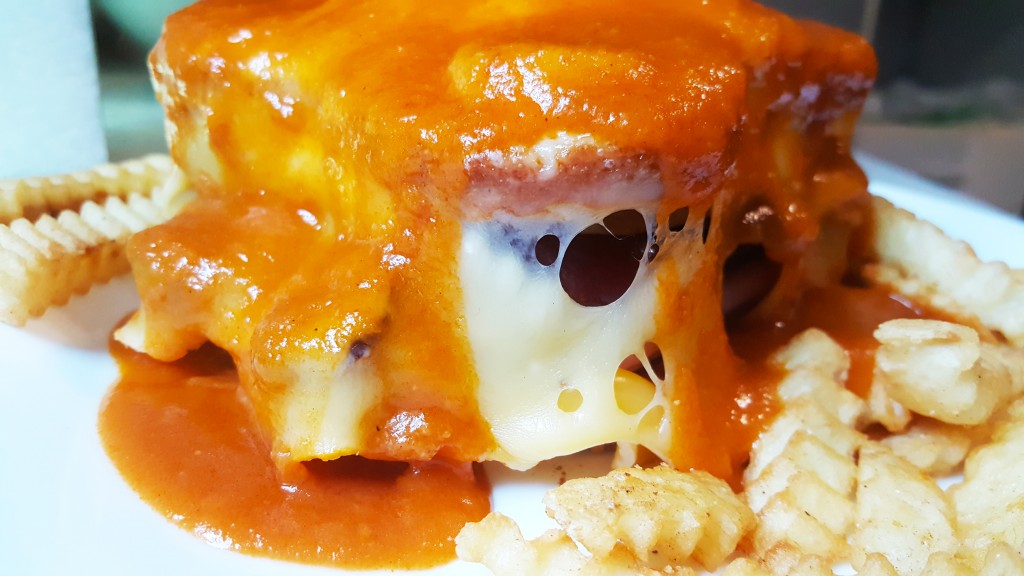
However, some of the simpler yet still delicious Portuguese sandwiches are. For example, the bifana, which is generally marinated, thin-sliced (or sometimes saucy and shredded) pork served in a papo seco roll (the crusty little oblong rolls we generally just call Portuguese rolls in the US) with, perhaps, some mustard and piri piri sauce.
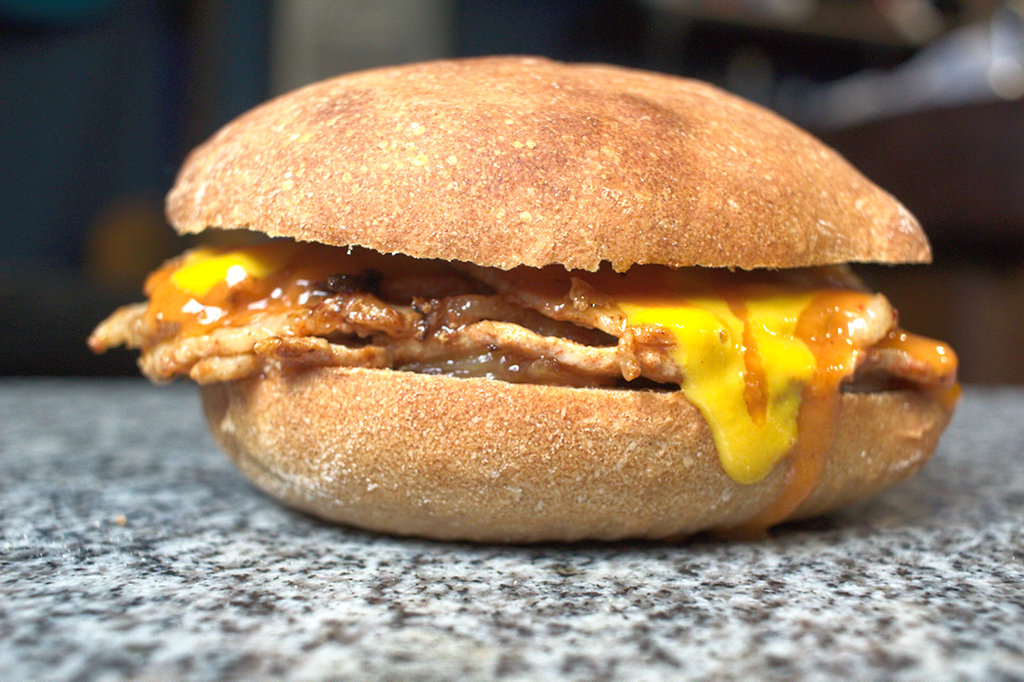
Here I took thin-sliced pork chops, removed the meat from the bones, pounded them thinner yet, then marinated them in a combination of white wine, white wine vinegar, olive oil, garlic, paprika, parsley, salt and pepper for a few hours before pan frying them, deglazing with a combination of chicken stock and reserved marinade, and simmering the pork in the pan sauce for a while until everything was warmed through and tender. I served these tasty and tender pieces of pork in the bolo do caco flatbreads spread with garlic butter, drizzling on a little pan sauce, piri piri sauce, and sweet yellow mustard.





It will probably not surprise you to learn that this was delicious. I myself am salivating rereading the description that I just typed. The quick sear of the pork followed by a slower, gentler simmer renders the chops suitably tender for sandwiches, where a dry or chewy piece of meat doesn’t bite through as cleanly. I bought center cut chops, which have sections of both leaner loin and a darker, richer tenderloin, and both were ideal.
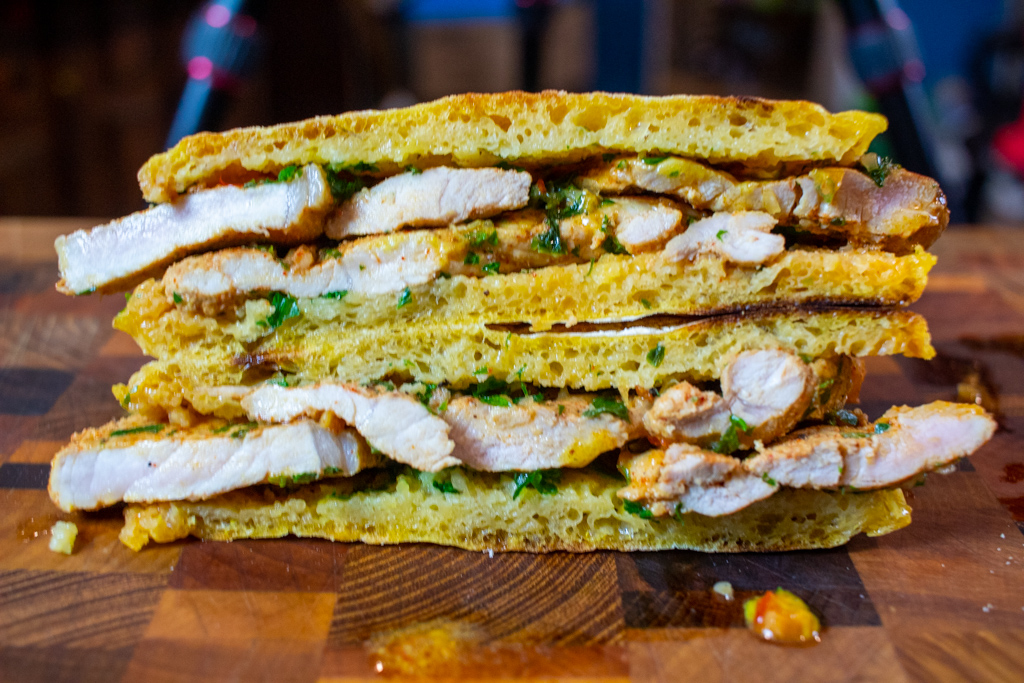
The pan sauce, savory from the chicken stock and deglazed bits of pork, was not entirely necessary to add to the sandwich, given the pleasant delicateness of the pork slices, but its savory, fruity flavor was a welcome addition to the sandwich. Peri-peri is a name for a flavorful hot sauce of Portuguese/South African origin, and I like the Kalahari African Rhino brand over more straightforwardly hot peri-peri sauces (though of course I get the HOT version)–it also has a citrusy tomato/garlic flavor that makes it a good accompaniment for meats. And Portuguese mustard is essentially much like the prepared yellow mustard we use commonly in the US but sweeter, so I added a little honey to some Plochman’s and it worked out pretty well.
But the one sandwich that is inevitably mentioned in writeups of bolo do caco is the Portuguese Prego. You may have seen the sandwich featured on Anthony Bourdain’s No Reservations, early in an episode they made about Lisbon, Portugal. (The episode is currently viewable here, with the sandwich entering the picture at about the 6:10 mark). Or I suppose it may be possible that you read about the sandwich on this site when I made a few different versions of it in 2018.
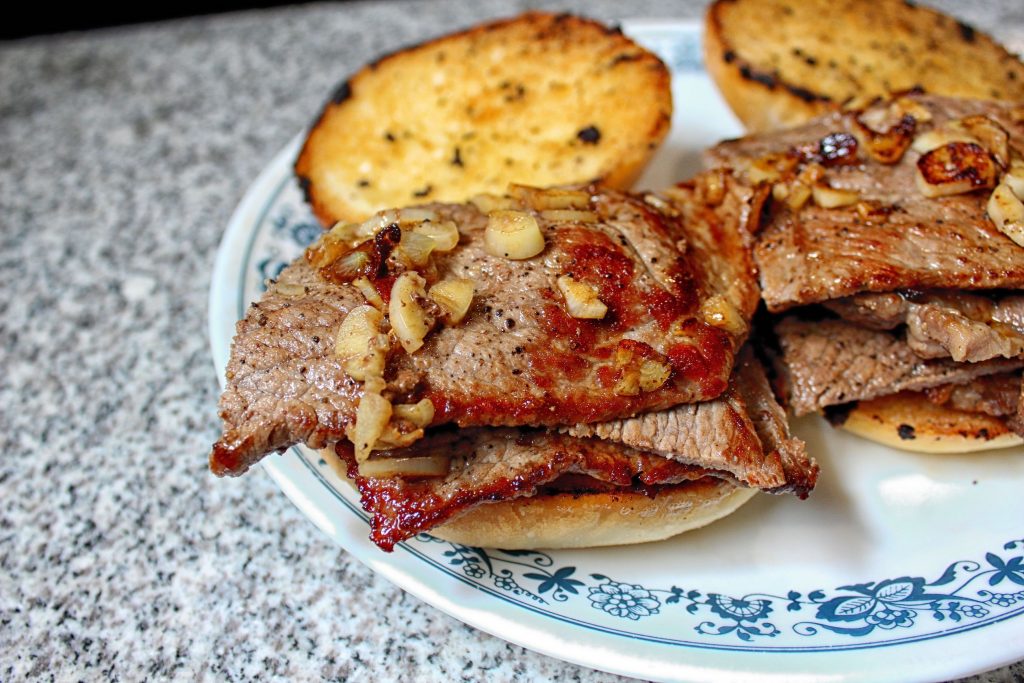
The Prego is a Portuguese sandwich native to Lisbon where it is often served as a dessert after a large meal of seafood. It consists of thin-sliced steak–sirloin is common, and what I use here–that is seasoned, browned, and served very simply. Prego, in Portuguese, means “nail,” and gets its name from slivers of raw garlic that are pounded into the raw steak before it is quickly browned in a griddle and served in a bread roll with sweet yellow mustard. There are fancier takes on the Prego–I tried at least one of them in the previous post linked above–but for this rendition I stuck with the classic form. I served these garlic-studded steaks in the bolo do caco flatbreads with the herb and garlic butter, and the garlicky peri-peri sauce, and the requisite sweet yellow mustard.



Have you noticed a theme in these sandwiches? Like most of the sandwiches I made with the bolo do caco, the Prego was quite garlic-forward. I couldn’t have been more pleased with it as a result. The sirloin, thin as it is and pounded thinner yet when the garlic is hammered into it, doesn’t really retain any pink color in the center, but it is cooked quickly enough not to dry out. Between this pleasantly fragrant meat, the garlic butter, and the dueling sauces, the sandwich is plenty juicy.
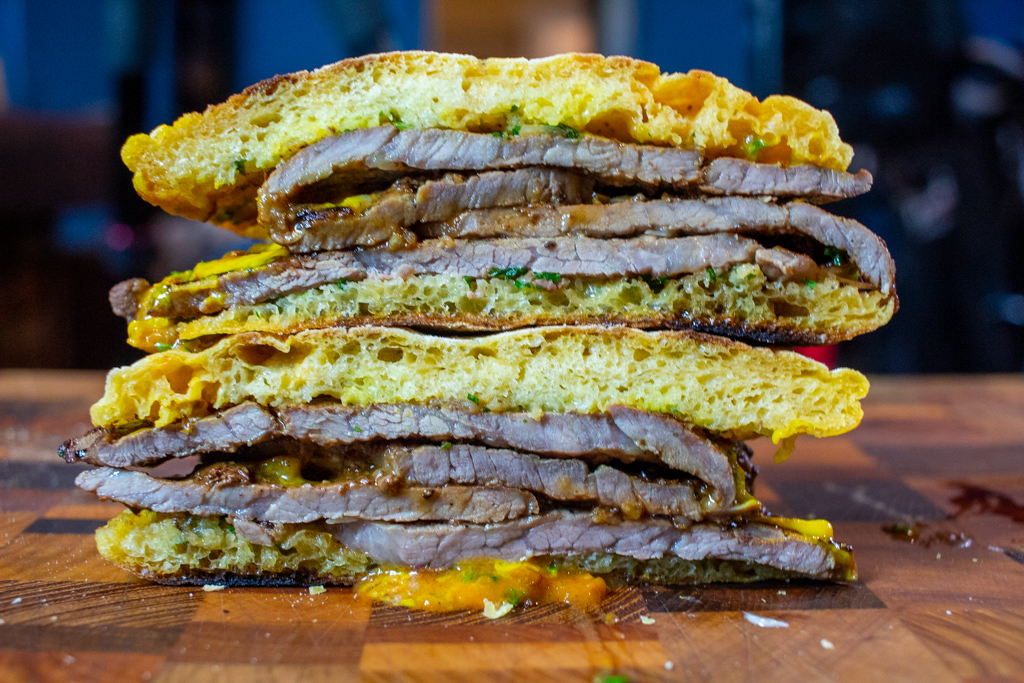
Some of the references I see to this sandwich call it, in Portuguese, “Prego em bolo do caco.” Others call it “Prego no bolo do caco.” But whichever preposition these articles use, every mention of this sandwich recommends it heartily, and for good reason. It’s a steak sandwich that doesn’t let much get between you and the steak. Serving the steak in a bolo do caco, a thinner bread than the usual, fuller-crumbed papo seco, makes the steak-to-everything-else ratio even higher. Good beef and garlic, savory hot sauce and mustard, with just enough bread to make it easier to lift up to your mouth–sandwich simplicity.

I like sandwiches.
I like a lot of other things too but sandwiches are pretty great


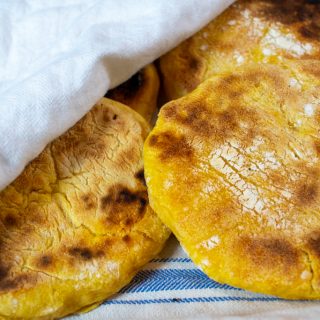














Recent Comments